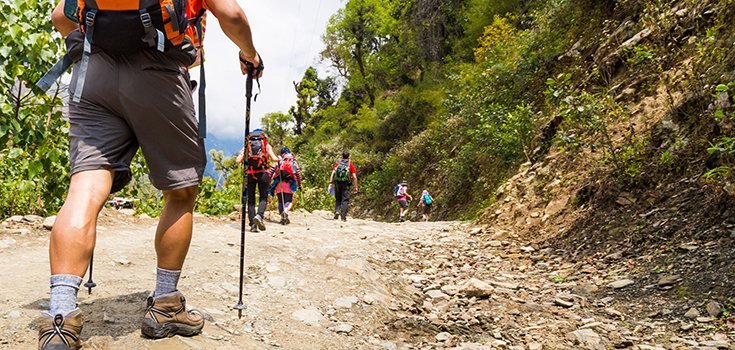Tips for a Safe and Exhilarating Fall Hike

Hiking in the fall gives you a chance to see some of nature’s most colorful art displays without the heat, humidity, and mosquitoes – assuming you don’t live in southern Florida or California, of course. If you’ve never been hiking in the fall in a cool climate, let me tell you: it’s worth the trip.
Walking in nature has been scientifically proven to rejuvenate the brain and help you “ruminate” less on negative self-talk. Who has time to for stinkin’ thinkin’ when you’re surrounding by brilliant reds, oranges, and yellows and the sound of falling leaves?
You have to be hyper-aware of your surroundings when you hike, regardless of the time of year, and each hiking season comes with some of its own unique risks.
Here are some tips to help you make sure you have a safe and memorable fall hiking experience.
Watch for hunters. Where I live, hunting is a big deal. People miss work and school for the first day of deer hunting season here. When I used to hike at a local wildlife preserve, it was very common to hear gunshots in the distance.
If you’ll be hiking near a known hunting area, wear a blaze orange vest so others can clearly see you. These vests are inexpensive and can be purchased at nearly any sporting goods store. You can usually pick one up at Walmart, too. [1]
If you come across hunters, make sure they’re aware of your presence. Clear your throat, wave your arms, say hello, hum, do whatever you want, but let them know you’re there.
If you hear gunshots in the distance, judge how far away they are, keep your eyes peeled, and remain visible. Sticking to national or state parks eliminates this concern entirely.
Additionally, if you’re traveling with a dog, keep him on a leash. It would be awful if your best friend got away from you and a hunter mistook him for prey. You can also buy blaze orange vests and collars for your dog.

Check the latest trail conditions. It snows earlier in some parts of the country than the rest, so make sure you know what you’re getting yourself into before you make the trek. [2]
Check for recent trip reports from fellow hikers to make sure your chosen trail is snow-free. Always call ahead to local ranger stations for conditions.
Snow aside, you don’t want to be caught in any kind of severe weather that could reduce visibility, chill you to the bone, or cause flooding.

- Source: NOAA
Pack extra essentials. This mostly applies if you’re planning to camp or you’re going to be hiking a long distance. Here are a few things you should have with you in a chilly, fall hike:
- Food
- Water
- Map
- Compass
- Headlamp with fresh batteries
- Emergency blanket
- Decent length parachute cord or emergency bracelet
- Sleeping bag liner
- Rain gear – a shell (hiking jacket), waterproof pants, wool socks (and extra ones)
- Reliable fire starter, such as cotton balls soaked in petroleum jelly and dry tinder
- Waterproof/storm-proof (water- and wind-proof) matches
- First aid kit
- Water bottle and water purifying tablets or personal water filter
Looking for a quality hiking shell? Here are Backpacker Magazine’s top picks for 2016.

- Source: Survival Mastery
You can buy waterproof or storm-proof matches at sporting goods stores (and, again, Walmart), but you don’t get many in a pack/bottle. You can always make your own waterproof matches, which requires a bit more effort, but is actually cheaper in the long-run.
You can also use turpentine to make your own storm-proof matches, but I’ll warn you: it can get kinda messy. (But it’s a fun kind of messy!)
Trust your instincts, and make sure someone knows where you are. As the autumn months turn into winter months, you might be chomping at the bit to get outside and enjoy every last ray of sunshine you can. But if your trip feels forced, or the forecast is sketchy, hold off on your hike. [1]
If you plan on going somewhere alone, make sure someone has your itinerary. If you’re going to an area you’re unfamiliar with, stay within your boundaries.
Sources:
[1] The Clymb
